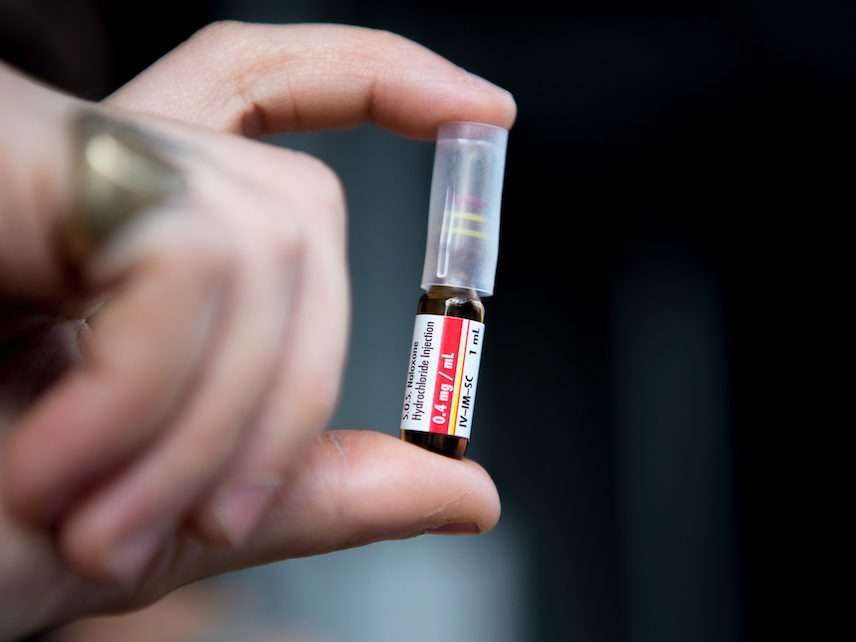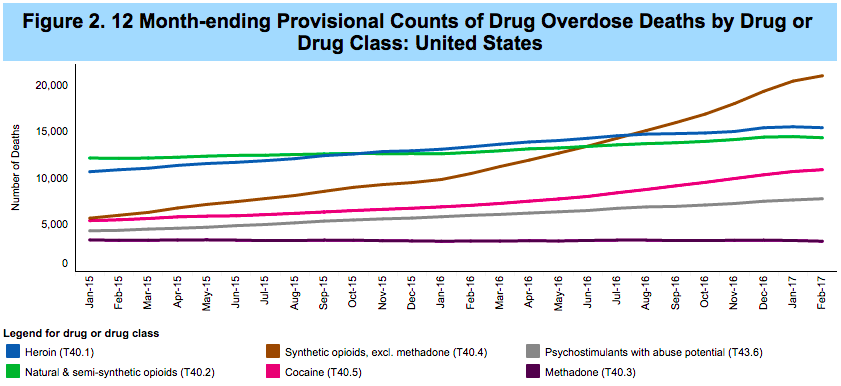New Hampshire's Medical Examiner: Opioid Deaths Have "Completely Overwhelmed Us"
New CDC data finds fentanyl deaths doubled in 2016.

In the six years since the federal government asked pharmaceutical companies to reformulate prescription opioids so patients couldn't use them illicitly, Thomas Andrew, the chief medical examiner of New Hampshire, has seen his caseload skyrocket.
"It's almost as if the Visigoths are at the gates, and the gates are starting to crumble," Andrew told The New York Times' Katharine Seelye. "I'm not an alarmist by nature, but this is not overhyped. It has completely overwhelmed us."
And he's not alone:
Some medical examiners, especially in hard-hit Ohio, have had to store their corpses in cold-storage trailers in their parking lots. In Manatee County, Fla., Dr. Russell Vega, the chief medical examiner, said that when he reaches "overflow" conditions, he relies on a private body transport service to store the bodies elsewhere until his office can catch up.
In Milwaukee, Dr. Brian L. Peterson, the chief medical examiner, said that apart from the "tsunami" of bodies — his autopsy volume is up 12 percent from last year — the national drug crisis has led to staff burnout, drained budgets and threats to the accreditation of many offices because they have to perform more autopsies than industry standards allow.
Andrew is leaving his job to enter a seminary. Meanwhile, the medical examiner's office in New Hampshire risks losing accreditation due to a National Association of Medical Examiners rule that says individual examiners may perform no more than 250 autopsies per year. We don't have enough places to store the bodies of overdose victims, nor enough people to cut them open.
We can thank bad policy for this carnage. The Centers for Disease Control have released preliminary data that show fentanyl-related deaths roughly doubled in 2016:

That brown line denotes the fentanyl class of drugs (conventional prescription opioids are the blue line, which has ticked up slightly but remains within historical range). Deaths involving fentanyl, which is more potent per milligram than more commonly prescribed opioids, doubled over the last year, from 10,000 in 2015 to 21,000 in 2016. Here are the actual numbers:

The category of natural and semi-synthetic opioids includes morphine, codeine, oxycodone, hydrocodone, hydromorphone, and oxymorphone. Those deaths increased, too, but nearly as much as the category that includes fentanyl. The fact that cocaine deaths increased as much as they did flummoxes me, but it perhaps shouldn't considering anecdotes from the northeastern U.S. about coke laced with fentanyl.
Why are so many more people using—and dying from—fentanyl? Because in 2010, the federal government began demanding that pharmaceutical companies create tamper-proof formulations. In more recent years, both the federal government and state governments have discouraged doctors from prescribing opioids for acute pain.
Combined, these actions greatly reduced the volume of prescription opioids available for non-medical use. But state actors did very little in conjunction with those policies to address the existing population of non-medical users, beyond locking up more people and modestly increasing the number of patients doctors can treat with buprenorphine and methadone.
That carelessness created a massive arbitrage opportunity for black market operators and introduced fentanyl into the American drugscape. The U.S. could not have planned a more effective epidemic.
*CORRECTION: The initial headline for this post claimed, based on a report from The New York Times, that New Hampshire Medical Examiner Thomas Andrew was quitting his job this year in response to the large number of opioid overdose deaths in his state. That claim is incorrect. In an interview with Alcoholism & Drug Abuse Weekly's Alison Knopf, Andrew said his retirement had been planned 15 years in advance.


Show Comments (100)